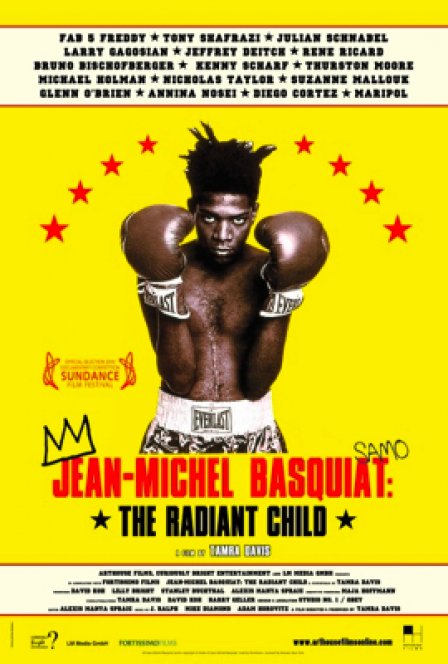The opening credits of Jean-Michel Basquiat: The Radiant Child immediately exhibit this documentary’s sense of clever, deliberate layering of visual and audio components. (See any number of docs with faux-weighty facts delivered via Powerpoint-style wipes — it’s more of a unique quality than you’d think.) Title card lettering drops in, character by character, in synchronization with the bebop backdrop of Dizzy Gillespie’s “Salt Peanuts.” Footage of the young artist dancing, working, and playing with pups in the studio scrambles alongside the frenetic song, as flashes of Jean-Michel Basquiat’s drawings and paintings are introduced. It’s lively as hell, and the scene for Basquiat’s irresistible story is effectively set.
Born in 1960, the Brooklyn-raised Basquiat, as the film notes early on, first became famous for his art, “and then he became famous for being famous, and then he became famous for being infamous.” The film plays out through a carefully constructed and impeccably paced narrative, wherein myriad aspects of Basquiat’s eight-year career trajectory are illuminated in choice detail. From the beginning, director and producer Tamra Davis makes her role within the documentary and her relation to the artist transparent: she discloses that the intimate recurring interview footage of Basquiat was something she filmed “of my friend” in 1986, two years before his death. The footage, which until now sat in a drawer for 20 years, serves as the film’s centerpiece and anchor, one of the many effective devices that brings the artist to life.
Davis starts the story in New York City in 1978, when Basquiat arrives in Manhattan after dropping out of high school. The downtown New York art world first takes notice when unusual, phrasal graffiti appears around the city credited to an unknown SAMO© (“same old shit”), who is Basquiat and friends incognito. The content is telling, too: “SAMO© AS A NEO ART FORM” and “SAMO© AS A RESULT OF OVEREXPOSURE” foreshadow the artist’s forthcoming rise and fall. Next, Basquiat naturally falls into the city’s No Wave music scene by playing in a band called Gray (his first public work, one interviewee says), and regularly appearing on Glenn O’Brien’s public access television show TV Party. Then Debbie Harry (Blondie) makes the first purchase of a Basquiat painting for $200, not long after he’s given the funds to work with paint on canvas for the first time. Shortly thereafter, Basquiat has work featured in The Times Square Show, “the first radical art show of the ‘80s,” alongside artists like Keith Haring. These events catalyze Basquiat’s efforts first into a viable career and then into a stratospheric presence as a top artist.
But the film’s allure doesn’t ride solely on the clarity with which this chain of events is rendered. It’s also the emotional ebb and flow in tandem with the narrative that the filmmakers maneuver to great effect. By ‘maneuver,’ I don’t mean any undue manipulation of the viewer, but an accounting for the audience’s progressing state of mind. Basquiat’s extraordinary story is told so compellingly here because of how the viewer is carried in emotional synchronization with him. We smile when he smiles, and we sigh when he sighs. He’s as charming as everyone tells us he is, and it’s easy to see how Basquiat ended up the leading figure in his cult of personality. Even Andy Warhol fell for him.
Beyond the artist’s personal life, the film does good work in contextualizing his art. The different personal likes that might figure into a present-day Facebook profile — like Basquiat’s love for bop jazz and the poetry of William Burroughs — are extracted from and discussed alongside his works. We’re shown with perfect clarity how he references and reinterprets their avant-garde techniques. Basquiat’s work is also discussed in a wide range of interviews that include art-world figures like dealer/gallery owner Larry Gagosian and Museum of Modern Art chief painting and sculpture curator Ann Temkin. Music and art historians are also called in, in addition to friends of the artist like Thurston Moore, Fab 5 Freddy, and Julian Schnabel. What we get is a fairly holistic exploration of Basquiat by those who knew him best.
But delving further into some of the problematic ways the work and the artist were received helps complete this representation of Basquiat the phenomenon. If he was famous for his fame and later his infamy, as The Radiant Child tells us, the film concludes that it was complicated and had as much to do with the persona outwardly attributed to him as the way he managed to cope with it. We’re shown interviews where Basquiat bucks back against racist, reductive characterizations of his art (primitive and primal: “Like an ape? A primate?” he charges) that apparently constituted an embarrassingly large portion of the white liberal art criticism that took him into consideration. At least Temkin, the MoMA authority, takes a moment to concede that people in positions like hers are so immersed in “established” art that it can be hard to deal with new art that makes them uncomfortable. Hindsight, etc. But by the time the film and artist’s inevitable end arrives, it’s hard to swallow that quick fade to black.

